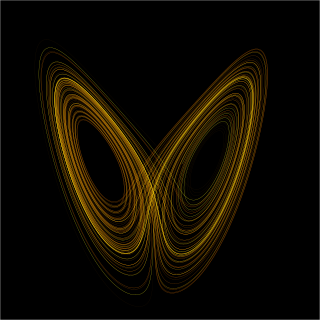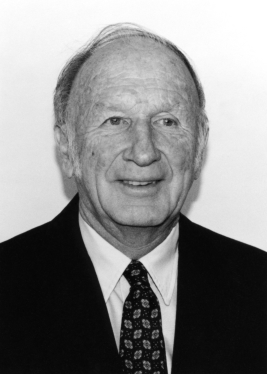Related Research Articles

In chaos theory, the butterfly effect is the sensitive dependence on initial conditions in which a small change in one state of a deterministic nonlinear system can result in large differences in a later state.

Chaos theory is an interdisciplinary area of scientific study and branch of mathematics focused on underlying patterns and deterministic laws of dynamical systems that are highly sensitive to initial conditions, and were once thought to have completely random states of disorder and irregularities. Chaos theory states that within the apparent randomness of chaotic complex systems, there are underlying patterns, interconnection, constant feedback loops, repetition, self-similarity, fractals, and self-organization. The butterfly effect, an underlying principle of chaos, describes how a small change in one state of a deterministic nonlinear system can result in large differences in a later state. A metaphor for this behavior is that a butterfly flapping its wings in Texas can cause a tornado in Brazil.
Predictability is the degree to which a correct prediction or forecast of a system's state can be made, either qualitatively or quantitatively.

Jule Gregory Charney was an American meteorologist who played an important role in developing numerical weather prediction and increasing understanding of the general circulation of the atmosphere by devising a series of increasingly sophisticated mathematical models of the atmosphere. His work was the driving force behind many national and international weather initiatives and programs.

Edward Norton Lorenz was an American mathematician and meteorologist who established the theoretical basis of weather and climate predictability, as well as the basis for computer-aided atmospheric physics and meteorology. He is best known as the founder of modern chaos theory, a branch of mathematics focusing on the behavior of dynamical systems that are highly sensitive to initial conditions.

The Lorenz system is a system of ordinary differential equations first studied by mathematician and meteorologist Edward Lorenz. It is notable for having chaotic solutions for certain parameter values and initial conditions. In particular, the Lorenz attractor is a set of chaotic solutions of the Lorenz system. The term "butterfly effect" in popular media may stem from the real-world implications of the Lorenz attractor, namely that several different initial chaotic conditions evolve in phase space in a way that never repeats, so all chaos is unpredictable. This underscores that chaotic systems can be completely deterministic and yet still be inherently unpredictable over long periods of time. Because chaos continually increases in systems, we cannot predict the future of systems well. E.g., even the small flap of a butterfly’s wings could set the world on a vastly different trajectory, such as by causing a hurricane. The shape of the Lorenz attractor itself, when plotted in phase space, may also be seen to resemble a butterfly.

Susan Solomon is an American atmospheric chemist, working for most of her career at the National Oceanic and Atmospheric Administration. In 2011, Solomon joined the faculty at the Massachusetts Institute of Technology, where she serves as the Ellen Swallow Richards Professor of Atmospheric Chemistry & Climate Science. Solomon, with her colleagues, was the first to propose the chlorofluorocarbon free radical reaction mechanism that is the cause of the Antarctic ozone hole.

Eugenia Enriqueta Kalnay is an Argentine meteorologist and a Distinguished University Professor of Atmospheric and Oceanic Science, which is part of the University of Maryland College of Computer, Mathematical, and Natural Sciences at the University of Maryland, College Park in the United States.
Phyllis Ann Fox was an American mathematician and computer scientist.

Yellowstone was the inaugural supercomputer at the NCAR-Wyoming Supercomputing Center (NWSC) in Cheyenne, Wyoming. It was installed, tested, and readied for production in the summer of 2012. The Yellowstone supercomputing cluster was decommissioned on December 31, 2017, being replaced by its successor Cheyenne.
Rebecca Suzanne Hornbrook is an atmospheric chemist at the National Center for Atmospheric Research (NCAR). She currently holds the position of Project Scientist II while also belonging to a variety of groups based out of NCAR, UCAR, and NASA. She is notable for her work as one of the leading experts in Volatile organic compounds (VOCs) while possessing an interest in air quality, biosphere-atmosphere interactions, chemical kinetics, and photochemistry.

Lai-yung Ruby Leung is an atmospheric scientist internationally recognized in the field of Earth Systems modeling and hydrologic processes. She is known for her contributions to the development of local climate models, and for her understanding of the consequences of climate change. Her interests are diverse across mountain hydrometeorology, aerosol-cloud interactions, orographic precipitation and climate extremes.
Maura E. Hagan is a Professor of Physics and Dean of the College of Science at Utah State University. She is a Fellow of both the American Meteorological Society and the American Geophysical Union, and was elected a member of the National Academy of Sciences in 2019.
Sonia Maria Kreidenweis is an American Professor of Atmospheric Sciences at Colorado State University. Her research considers aerosols and their impact on weather and the climate. She has previously served as President of the American Association for Aerosol Research and was a board member of the American Meteorological Society. She was elected a Fellow of the American Geophysical Union in 2019.
Emily V. Fischer is an atmospheric chemist and an associate professor in the department of atmospheric science at Colorado State University. She earned notoriety from her work on the WE-CAN project and on PAN, specifically its role in changing the distribution of oxidants in the troposphere. She has received many honors including the prestigious James B. Macelwane Medal which is "given annually to three to five early career scientists in recognition of their significant contributions to Earth and space science." Fischer is also a role model and activist in galvanizing support for women in STEM fields.
Annick Gabrielle Pouquet is a computational plasma physicist specializing in plasma turbulence. She was awarded the 2020 Hannes Alfvén Prize for "fundamental contributions to quantifying energy transfer in magneto-fluid turbulence". She currently holds positions in the Laboratory for Atmospheric and Space Physics and National Center for Atmospheric Research at the University of Colorado Boulder.
Natalie Mahowald is an American Earth scientist who is the Irving Porter Church Professor of Engineering at Cornell University. Her research considers atmospheric transport of biogeochemically-relevant species, and the impact of humans on their environments.
Sarah Gille is a physical oceanographer at Scripps Institution of Oceanography known for her research on the role of the Southern Ocean in the global climate system.
Susan Claire van den Heever is a South African atmospheric scientist who is a professor at Colorado State University. Her research considers cloud physics and mesoscale modelling. She is a fellow of the American Meteorological Society and an editor of the Journal of the Atmospheric Sciences.

Sonya Legg is a British oceanographer who is Director of the Center for Ocean Leadership. She studies the physical and dynamical processes of ocean circulation. Legg is involved with various initiatives to improve the representation of women in geoscience. She was Chair of the Mentoring Physical Oceanography Women to Increase Retention (MPOWIR) and is the co-chair of the Scientific Steering Group that directs the work of CLIVAR.
References
- ↑ "Deaths" (PDF). Friends Journal. 1992. Retrieved 2019-05-24.
- ↑ dpulley1. "Fetter Chamber Group Gives Back | Music and Dance" . Retrieved 2019-05-24.
{{cite web}}: CS1 maint: numeric names: authors list (link) - 1 2 "John Gille to Wed Miss Ellen Fetter". The New York Times. 1963-07-14. ISSN 0362-4331 . Retrieved 2019-05-24.
- ↑ "New Trier Class of 1957". newtrier57.org. Retrieved 2019-05-24.
- ↑ College, Mount Holyoke. "Honor Roll". blog.mtholyoke.edu. Archived from the original on 2019-05-24. Retrieved 2019-05-24.
- 1 2 3 4 5 Sokol, Joshua (20 May 2019). "The Hidden Heroines of Chaos". Quanta Magazine. Archived from the original on 21 January 2022. Retrieved 2019-05-24.
- ↑ Lorenz, Edward N. (1963-03-01). "Deterministic Nonperiodic Flow". Journal of the Atmospheric Sciences. 20 (2): 130–141. Bibcode:1963JAtS...20..130L. doi: 10.1175/1520-0469(1963)020<0130:DNF>2.0.CO;2 . ISSN 0022-4928.
- ↑ "John Gille | staff.ucar.edu". staff.ucar.edu. Retrieved 2019-05-28.
- ↑ "Sarah Gille". Archived from the original on 2019-01-31. Retrieved 2019-07-01.
- ↑ "Sarah Gille". Archived from the original on 2023-12-01. Retrieved 2024-02-08.